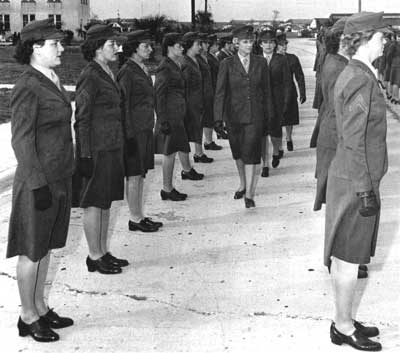
Increased manpower requirements forced all of the services to re-evaluate their recruiting strategies. Sheer necessity opened the doors to African-Americans, Native Americans, women and other minority groups during World War II. The Marine Corps was the last service to make changes to recruiting policies. On February 13, 1943, the Marine Corps opened its doors to women for the first time since World War I. By the war's end, there were more than 20,000 women on active duty. The Marine Corps has not seen that many women on active duty since.
Women in each of the other services acquired nicknames with their active duty status. Navy women became WAVES. Army women became WAACS. Debate over a nickname for women in the Marines varied from the Marinettes of World War I to Femarines. General Thomas Holcomb settled the matter with a finality distinctive of the Marines. Initially an ardent opponent of women in the Corps, a quote in the March 27, 1944 issue of

|
| Col Katherine A. Towle, second director of the Marine Corps Women's Reserve, conducts an inspection in the winter service green at Marine Corps Recruit Depot (MCRD), Parris Island, in 1945. Photo courtesy of Sarah Thornton from Marines in World War II Commemorative Series, Marine Corps History Division |
They are Marines. They don't have a nickname and they don't need one. . . They inherit the traditions of Marines. They are Marines.
This page looks at some of the key aspects of integrating women into the Marine Corps in World War II.
The Marine Corps was the last service to accept women. This enabled them to learn from the other services, and to improve upon what had already been done. On February 13, 1943, the Marine Corps finally began accepting women recruits.
Before the first recruits arrived for training, Marine Corps leadership had selected seven women whom they viewed as critical to the success of women in the Marine Corps. They sought college-eduated women to be officers, who came from good backgrounds, with solid moral character. First of these, Ruth Streeter, would become the first Director of what would be called the Marine Corps Women's Reserve (MCWR).
Initially, the Marine Corps relied upon the Navy's training facilities for both its officers and its enlisted women. Classes began in March 1943 for both officer candidates and recruits. The first class of recruits (722 total) completed their recruit training at Hunter College, in The Bronx, New York. In July 1943, the Marine Corps transferred officer and recruit training to more permanent facilities in New River, North Carolina. Nearly 19,000 women would complete their training at New River during the course of the war.
The first group of women officers received direct commissions, based on their ability, education and civilian expertise. The first class of officer candidates began training at Mount Holyoke College in South Hadley, Massachusetts on March 13, 1943, just one month after the Marine Corps began accepting women.
In July 1943, the Marine Corps transferred both officer and recruit training to more permanent facilities at New River, North Carolina.
The primary purpose for women in all the services during World War II was to "free a man to fight". Therefore, the women often performed jobs that military leadership viewed as appropriate for women, jobs that could be performed in the continental United States, and that kept a woman's feminine image solidly in place.
However, the needs of the Marine Corps sometimes outweighed the wishes of Marine Corps leadership. Women became mechanics and worked on electronics, drove trucks and got dirty. The list below offers an idea of the more than 200 types of jobs women might expect in the Marine Corps.
All women in the Marine Corps worked for two different leadership chains of command. First, they worked for their immediate supervisors, in the traditional military unit chain of command. That meant they were usually reporting directly to men. However, a second chain of command existed. As in the other services, the Marine Corps created the position of Director, Women Marine Corps Reserve (MCWR). This ensured that specific administrative, assignment and miscellaneous needs of women were met.
There was no retention plan for women in World War II. The Marine Corps - indeed, the whole country - saw women in the military as a wartime necessity. Once the war concluded, women would return to their traditional family roles. Once the war ended, women would fight an uphill battle to become a permanent part of the military institution.